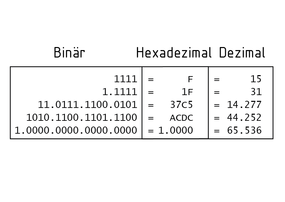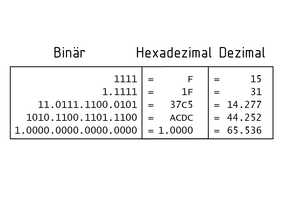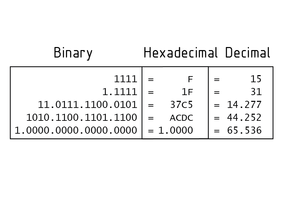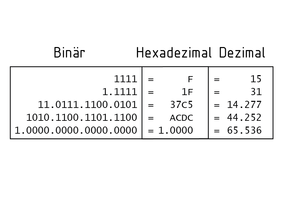
一种定义
四种语言
0,1,2
- 德國
- 英語
- 中國
- 西班牙語
数制

数制按进位的原则进行计数。加法、混合运算和位置计数法均有所区别。
位置计数法(又称为位值制,多元数制)包括十进、二进制和十六进制。十进制的数字系统中有0到9这10个数字,二进制只有0和1,十六进制由数字0-9和字母A-F组成,这种数制法多用于数据的处理和计算。数字 9之后是字母 A-F,F后面是两位数,从10到 1F,再之后是三数 100、101等等。
不同的进制之间可以相互转化。例如,利用余数或者除法可以将十进制转化为十六进制。
二进制,十六进制和十进制的比较
近义词
位值制
多数制
十进制
十进制
二进制
二进制
十六进制
Zahlensystem

Ein Zahlensystem stellt Zahlen in Form von Ziffern dar. Dafür werden Additions-, Hybrid- und Stellenwertsysteme unterschieden.
Stellenwertsysteme (Positionssystem, polyadisches Zahlensystem) sind z. B. das Dezimalsystem, das Dualsystem (binäres Zahlensystem) oder das Hexadezimalsystem. Das Dezimalsystem (dekadisches System, Zehnersystem) ist ein Zahlensystem, das aus den zehn Ziffern 0 bis 9 besteht. Das Dualsystem wird auch Binärsystem genannt und besteht nur aus Nullen und Einsen. Das Hexadezimalsystem setzt sich aus 0 bis 9 und A bis F zusammen. Bei diesem Stellenwertsystem, welches bevorzugt in der Datenverarbeitung genutzt wird, wird nach der Zahl 9 mit A bis F weitergezählt. Nach F folgen zweistellige Zahlen, beginnend mit 10 bis 1F, danach die dreistelligen Zahlen 100, 101 usw.
Die einzelnen Stellenwertsysteme lassen sich ineinander umwandeln. Mit dem Restwert- oder Divisionsverfahren werden beispielsweise Dezimal- in Hexadezimalzahlen umgewandelt.
Numeral system

A numeral system expresses numbers in the form of digits. A distinction is made between addition, hybrid and positional notation systems.
Positional notation systems (place value system, polyadic numeral system) include the decimal system, the dual system (binary numeral system) and the hexadecimal system. The decimal system (decadic / decade system) is a system comprising the ten digits 0 to 9. The dual system is also called the binary system and consists of zeros and ones only. The hexadecimal system is made up of the digits 0 to 9 and the letters A to F. In this positional notation system, which is the preferred system for data processing, counting continues after 9 with the letters A to F. F is followed by two-character values, from 10 to 1F, and then by the three-character values 100, 101, etc.
The individual positional notation systems can be converted from one to the other. For example, the residual or division method is used to convert decimals into hexadecimals.
Sistema de numeración

Un sistema de numeración expresa números en forma de dígitos. Se distingue entre los sistemas de notación posicional, de suma e híbrido.
Los sistemas de notación posicional (sistema de valor posicional, sistema de numeración poliádico) incluyen el sistema decimal, el sistema doble (sistema de numeración binaria) y el sistema hexadecimal. El sistema decimal (decádico) es un sistema que comprende diez dígitos del 0 al 9. El sistema doble también se llama sistema binario y consiste en ceros y unos solamente. El sistema hexadecimal está compuesto por dígitos del 0 al 9 y las letras de A a la F. En este sistema de notación posicional, que es el sistema preferido para el procesamiento de datos, se continúa contando después de 9 con las letras de la A a la F. La F es seguida por valores de dos caracteres, del 10 al 1F, y luego por valores de tres caracteres, 100, 101, etc.
Los sistemas de notación posicional individuales pueden ser convertidos de uno al otro. Por ejemplo, el método de división o residual se usa para convertir decimales a hexadecimales.
Comparación de los sistemas binario, hexadecimal y decimal
